International Finance: HSBC Bank's Risk Management Strategies Report
VerifiedAdded on 2023/01/23
|10
|2227
|56
Report
AI Summary
This comprehensive report delves into the intricacies of international finance, with a specific focus on risk management within HSBC Bank. It begins with an executive summary outlining the report's purpose: to understand the exposures faced by multinational companies. The report explores key concepts in international finance management and risk management, using HSBC as a case study. It provides an overview of HSBC, a major global financial service provider, before delving into the specifics of risk management. The report discusses transactional, exchange rate, and economic exposures, explaining the risks associated with each and the techniques HSBC uses to manage them. These techniques include various approaches to managing transactional risks, such as the use of risk metrics, historical simulations, and Monte Carlo simulations. It also covers hedging strategies and operational techniques. The report then examines exchange rate exposure and how HSBC uses the Risk Metric method to measure market risks, along with hedging and invoicing strategies. Finally, it explores economic exposure, also known as operational risk, and the operational and currency risk mitigation strategies employed by HSBC. The report concludes by summarizing how these techniques contribute to operational and economic efficiency, emphasizing the importance of proactive risk management in the dynamic landscape of international finance.
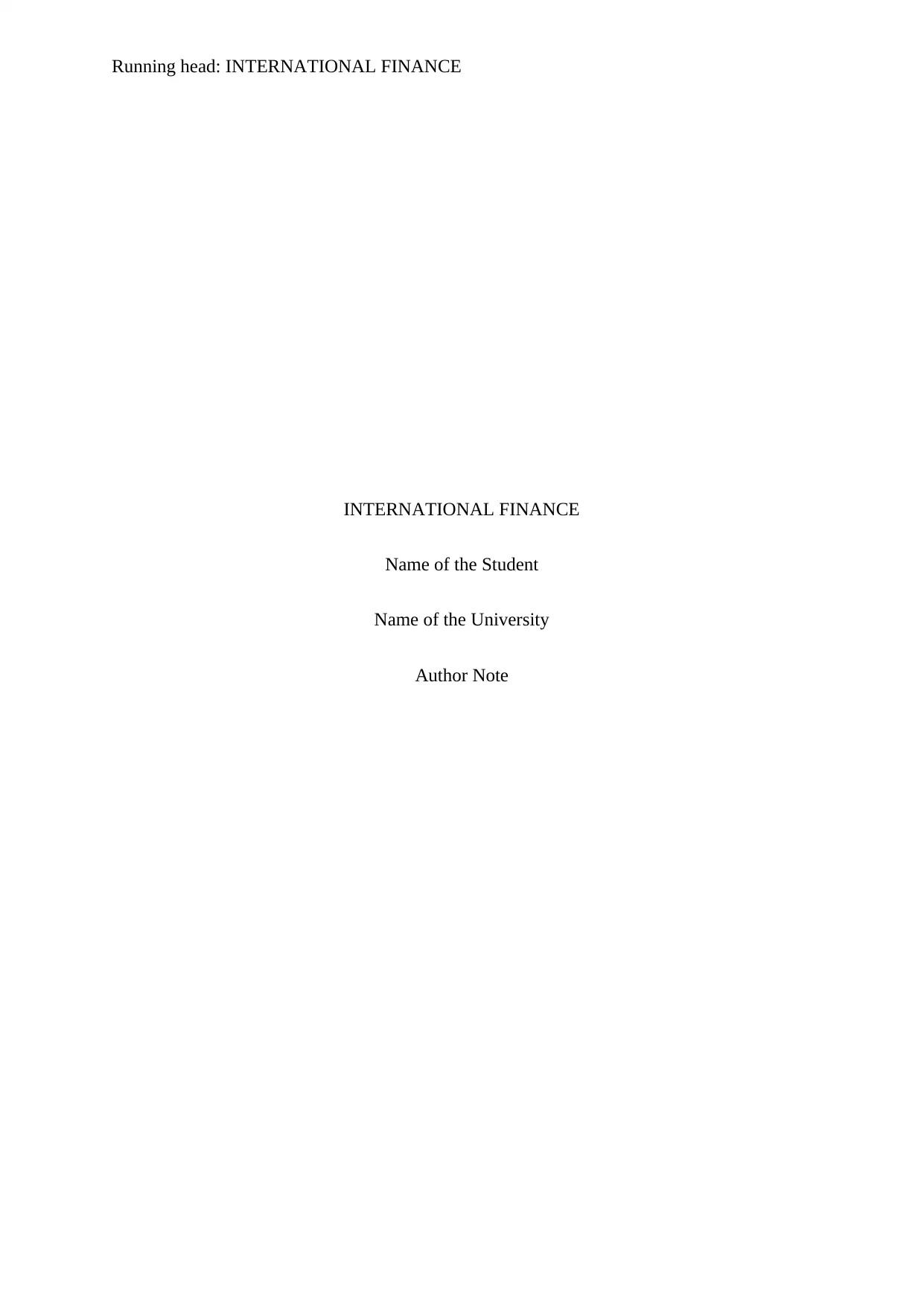
Running head: INTERNATIONAL FINANCE
INTERNATIONAL FINANCE
Name of the Student
Name of the University
Author Note
INTERNATIONAL FINANCE
Name of the Student
Name of the University
Author Note
Paraphrase This Document
Need a fresh take? Get an instant paraphrase of this document with our AI Paraphraser

1INTERNATIONAL FINANCE
Executive Summary
The purpose of the business report is to understand the various exposures associated with the
multinational companies. It helps in understanding the international finance in details. This
report discusses about the concept of international finance management and risk
management. In order to explain in details HSBC Bank has been considered and how it
manages its market risks are discussed. The transactional risks, exchange risks and economic
risks are explained in details and the techniques used by HSBC to manage these risks are
clearly explained. The report is concluded by summarising how the operational and economic
efficiency of the organisation can be managed by these techniques.
Executive Summary
The purpose of the business report is to understand the various exposures associated with the
multinational companies. It helps in understanding the international finance in details. This
report discusses about the concept of international finance management and risk
management. In order to explain in details HSBC Bank has been considered and how it
manages its market risks are discussed. The transactional risks, exchange risks and economic
risks are explained in details and the techniques used by HSBC to manage these risks are
clearly explained. The report is concluded by summarising how the operational and economic
efficiency of the organisation can be managed by these techniques.
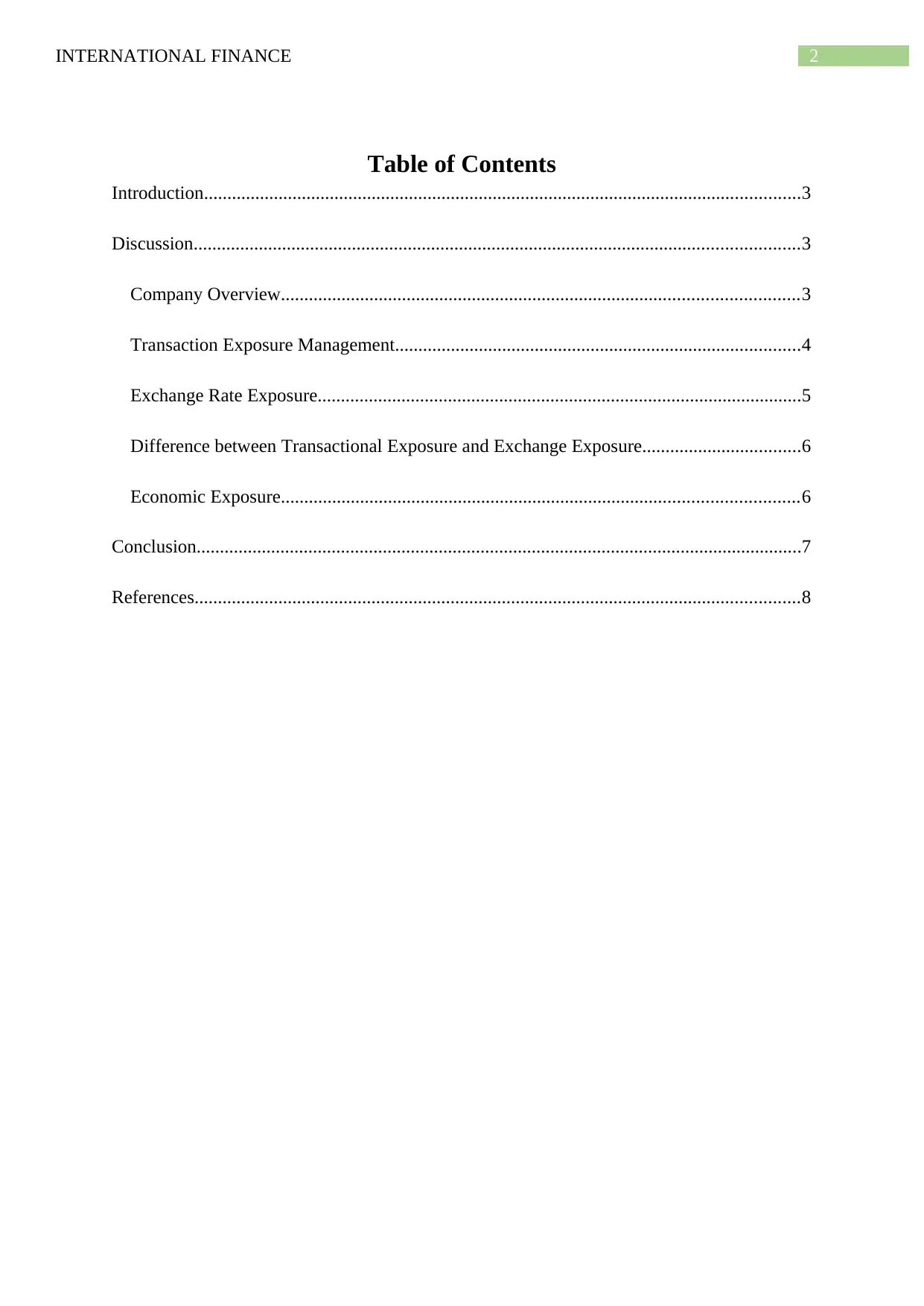
2INTERNATIONAL FINANCE
Table of Contents
Introduction................................................................................................................................3
Discussion..................................................................................................................................3
Company Overview...............................................................................................................3
Transaction Exposure Management.......................................................................................4
Exchange Rate Exposure........................................................................................................5
Difference between Transactional Exposure and Exchange Exposure..................................6
Economic Exposure...............................................................................................................6
Conclusion..................................................................................................................................7
References..................................................................................................................................8
Table of Contents
Introduction................................................................................................................................3
Discussion..................................................................................................................................3
Company Overview...............................................................................................................3
Transaction Exposure Management.......................................................................................4
Exchange Rate Exposure........................................................................................................5
Difference between Transactional Exposure and Exchange Exposure..................................6
Economic Exposure...............................................................................................................6
Conclusion..................................................................................................................................7
References..................................................................................................................................8
⊘ This is a preview!⊘
Do you want full access?
Subscribe today to unlock all pages.

Trusted by 1+ million students worldwide

3INTERNATIONAL FINANCE
Introduction
Financial management refers to the management of the financial issues that arises in
the international business environment. A multinational company performs its activities all
over the world. Financial policies and issues vary from place to place. Different countries
have different currency, different environment condition, political situation, opportunities and
varied market situations. Proper management system must be there for the management of the
risks that are associated for varied conditions of different countries. Risk management is
therefore necessary to prevent the companies form several market exposures. Risk
management refers to the assessment and analysis of the financial risks along with the
determination of the procedures and the methods to minimize the impact of the risks (Stulz
2015). Several risk management theories and international financial management theories are
applied in order to manage the risks.
The company chosen in this report is HSBC. Banking sectors have a lot of risk
associated with it. The risks can be classified as – Transaction risk, credit risk, strategic risk,
compliance risk, liquidity risk, market risk, systemic risk, reputational risk, operational risk,
open banking risk, cyber security risk, foreign exchange risk, interest rate risk and many
more (Bromiley et al. 2015). The following paragraph explains about the risks associated
with this bank and its risk management techniques.
Discussion
Company Overview
HSBC has been one of the largest banking and financial service provider of the world.
It serves more than 39 millions of customers worldwide by providing services like retail
banking, commercial banking, global banking, wealth management and global private
banking. The bank has coverage in 66 countries and territories all over the world. It was
Introduction
Financial management refers to the management of the financial issues that arises in
the international business environment. A multinational company performs its activities all
over the world. Financial policies and issues vary from place to place. Different countries
have different currency, different environment condition, political situation, opportunities and
varied market situations. Proper management system must be there for the management of the
risks that are associated for varied conditions of different countries. Risk management is
therefore necessary to prevent the companies form several market exposures. Risk
management refers to the assessment and analysis of the financial risks along with the
determination of the procedures and the methods to minimize the impact of the risks (Stulz
2015). Several risk management theories and international financial management theories are
applied in order to manage the risks.
The company chosen in this report is HSBC. Banking sectors have a lot of risk
associated with it. The risks can be classified as – Transaction risk, credit risk, strategic risk,
compliance risk, liquidity risk, market risk, systemic risk, reputational risk, operational risk,
open banking risk, cyber security risk, foreign exchange risk, interest rate risk and many
more (Bromiley et al. 2015). The following paragraph explains about the risks associated
with this bank and its risk management techniques.
Discussion
Company Overview
HSBC has been one of the largest banking and financial service provider of the world.
It serves more than 39 millions of customers worldwide by providing services like retail
banking, commercial banking, global banking, wealth management and global private
banking. The bank has coverage in 66 countries and territories all over the world. It was
Paraphrase This Document
Need a fresh take? Get an instant paraphrase of this document with our AI Paraphraser
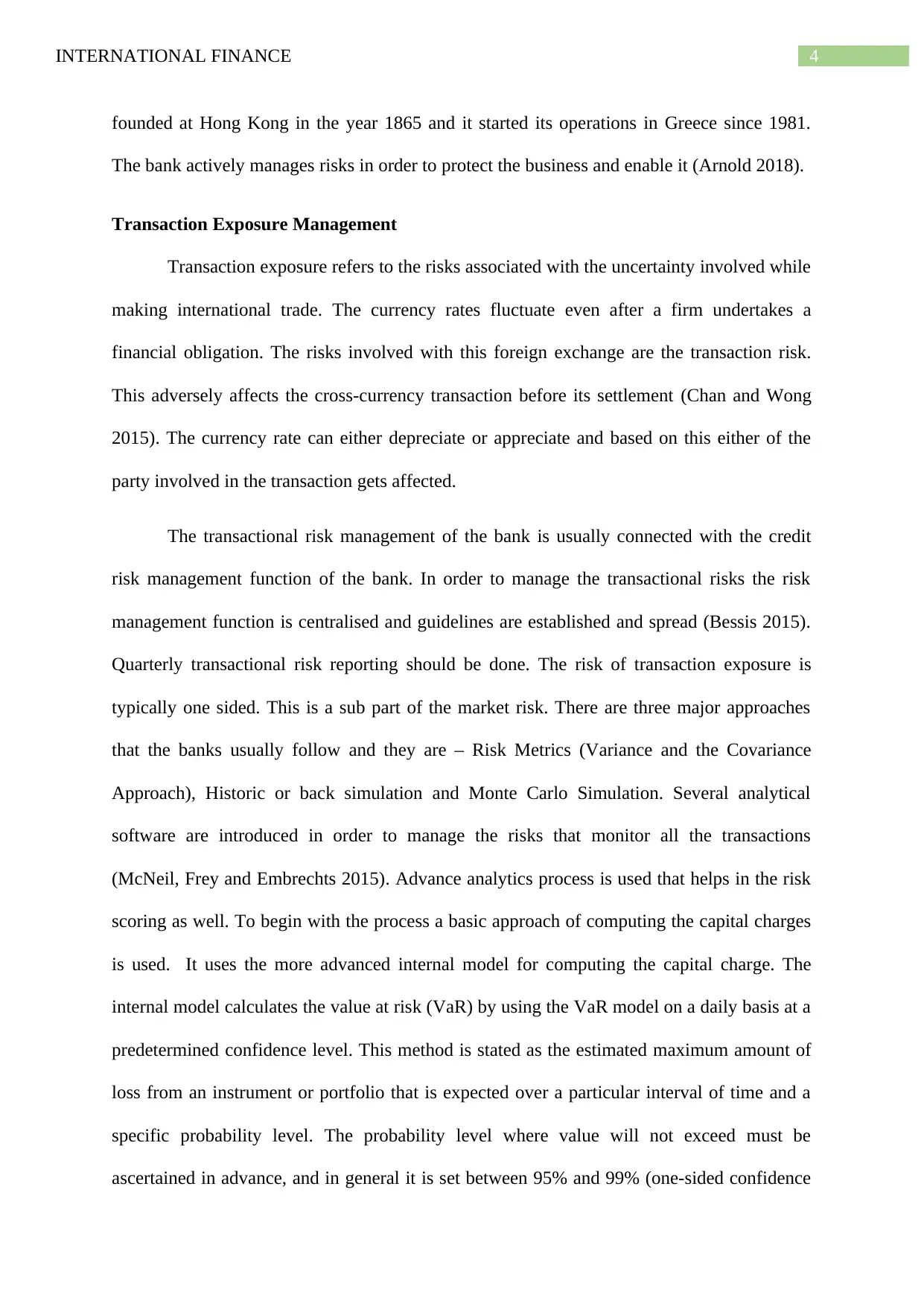
4INTERNATIONAL FINANCE
founded at Hong Kong in the year 1865 and it started its operations in Greece since 1981.
The bank actively manages risks in order to protect the business and enable it (Arnold 2018).
Transaction Exposure Management
Transaction exposure refers to the risks associated with the uncertainty involved while
making international trade. The currency rates fluctuate even after a firm undertakes a
financial obligation. The risks involved with this foreign exchange are the transaction risk.
This adversely affects the cross-currency transaction before its settlement (Chan and Wong
2015). The currency rate can either depreciate or appreciate and based on this either of the
party involved in the transaction gets affected.
The transactional risk management of the bank is usually connected with the credit
risk management function of the bank. In order to manage the transactional risks the risk
management function is centralised and guidelines are established and spread (Bessis 2015).
Quarterly transactional risk reporting should be done. The risk of transaction exposure is
typically one sided. This is a sub part of the market risk. There are three major approaches
that the banks usually follow and they are – Risk Metrics (Variance and the Covariance
Approach), Historic or back simulation and Monte Carlo Simulation. Several analytical
software are introduced in order to manage the risks that monitor all the transactions
(McNeil, Frey and Embrechts 2015). Advance analytics process is used that helps in the risk
scoring as well. To begin with the process a basic approach of computing the capital charges
is used. It uses the more advanced internal model for computing the capital charge. The
internal model calculates the value at risk (VaR) by using the VaR model on a daily basis at a
predetermined confidence level. This method is stated as the estimated maximum amount of
loss from an instrument or portfolio that is expected over a particular interval of time and a
specific probability level. The probability level where value will not exceed must be
ascertained in advance, and in general it is set between 95% and 99% (one-sided confidence
founded at Hong Kong in the year 1865 and it started its operations in Greece since 1981.
The bank actively manages risks in order to protect the business and enable it (Arnold 2018).
Transaction Exposure Management
Transaction exposure refers to the risks associated with the uncertainty involved while
making international trade. The currency rates fluctuate even after a firm undertakes a
financial obligation. The risks involved with this foreign exchange are the transaction risk.
This adversely affects the cross-currency transaction before its settlement (Chan and Wong
2015). The currency rate can either depreciate or appreciate and based on this either of the
party involved in the transaction gets affected.
The transactional risk management of the bank is usually connected with the credit
risk management function of the bank. In order to manage the transactional risks the risk
management function is centralised and guidelines are established and spread (Bessis 2015).
Quarterly transactional risk reporting should be done. The risk of transaction exposure is
typically one sided. This is a sub part of the market risk. There are three major approaches
that the banks usually follow and they are – Risk Metrics (Variance and the Covariance
Approach), Historic or back simulation and Monte Carlo Simulation. Several analytical
software are introduced in order to manage the risks that monitor all the transactions
(McNeil, Frey and Embrechts 2015). Advance analytics process is used that helps in the risk
scoring as well. To begin with the process a basic approach of computing the capital charges
is used. It uses the more advanced internal model for computing the capital charge. The
internal model calculates the value at risk (VaR) by using the VaR model on a daily basis at a
predetermined confidence level. This method is stated as the estimated maximum amount of
loss from an instrument or portfolio that is expected over a particular interval of time and a
specific probability level. The probability level where value will not exceed must be
ascertained in advance, and in general it is set between 95% and 99% (one-sided confidence
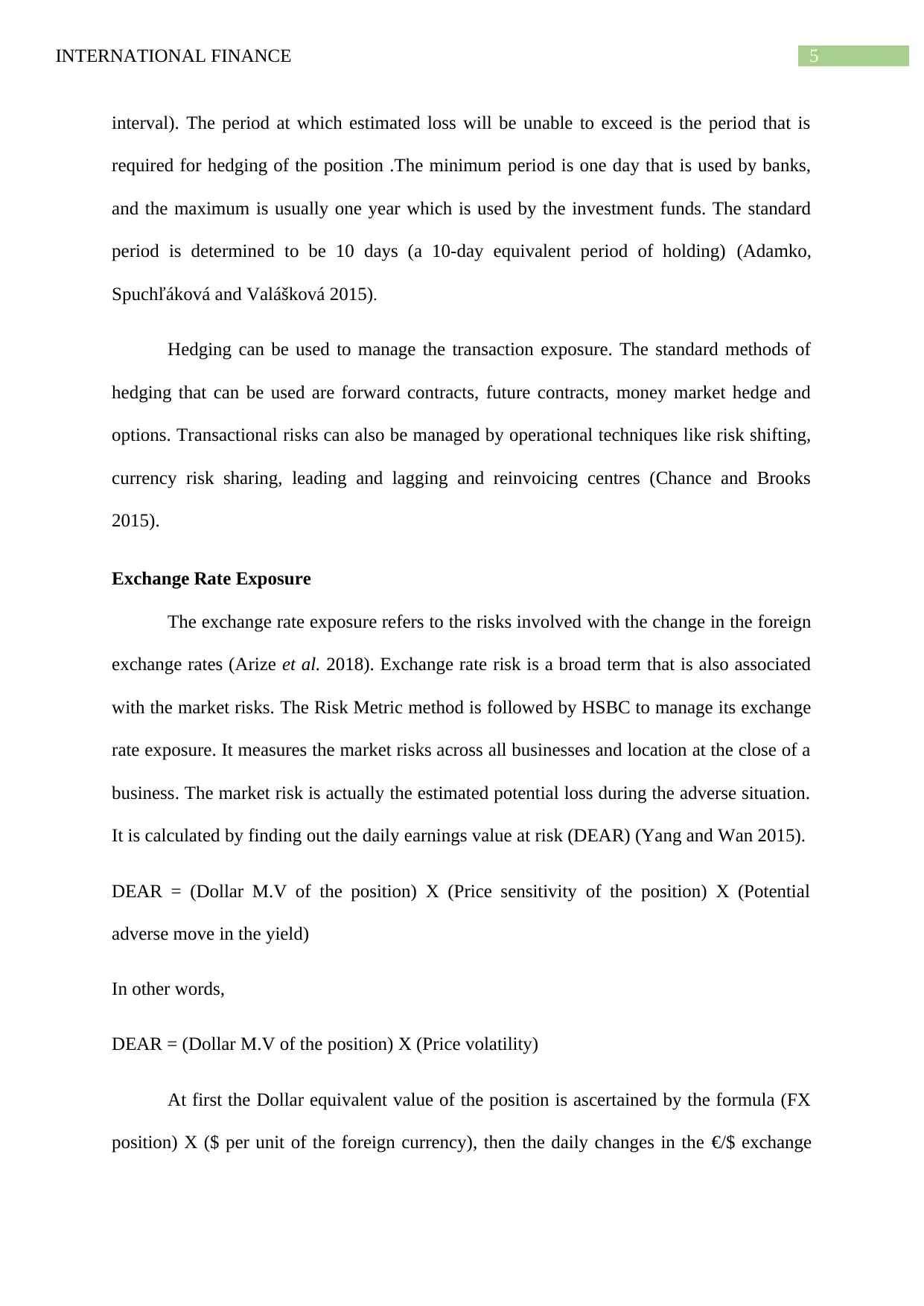
5INTERNATIONAL FINANCE
interval). The period at which estimated loss will be unable to exceed is the period that is
required for hedging of the position .The minimum period is one day that is used by banks,
and the maximum is usually one year which is used by the investment funds. The standard
period is determined to be 10 days (a 10-day equivalent period of holding) (Adamko,
Spuchľáková and Valášková 2015).
Hedging can be used to manage the transaction exposure. The standard methods of
hedging that can be used are forward contracts, future contracts, money market hedge and
options. Transactional risks can also be managed by operational techniques like risk shifting,
currency risk sharing, leading and lagging and reinvoicing centres (Chance and Brooks
2015).
Exchange Rate Exposure
The exchange rate exposure refers to the risks involved with the change in the foreign
exchange rates (Arize et al. 2018). Exchange rate risk is a broad term that is also associated
with the market risks. The Risk Metric method is followed by HSBC to manage its exchange
rate exposure. It measures the market risks across all businesses and location at the close of a
business. The market risk is actually the estimated potential loss during the adverse situation.
It is calculated by finding out the daily earnings value at risk (DEAR) (Yang and Wan 2015).
DEAR = (Dollar M.V of the position) X (Price sensitivity of the position) X (Potential
adverse move in the yield)
In other words,
DEAR = (Dollar M.V of the position) X (Price volatility)
At first the Dollar equivalent value of the position is ascertained by the formula (FX
position) X ($ per unit of the foreign currency), then the daily changes in the €/$ exchange
interval). The period at which estimated loss will be unable to exceed is the period that is
required for hedging of the position .The minimum period is one day that is used by banks,
and the maximum is usually one year which is used by the investment funds. The standard
period is determined to be 10 days (a 10-day equivalent period of holding) (Adamko,
Spuchľáková and Valášková 2015).
Hedging can be used to manage the transaction exposure. The standard methods of
hedging that can be used are forward contracts, future contracts, money market hedge and
options. Transactional risks can also be managed by operational techniques like risk shifting,
currency risk sharing, leading and lagging and reinvoicing centres (Chance and Brooks
2015).
Exchange Rate Exposure
The exchange rate exposure refers to the risks involved with the change in the foreign
exchange rates (Arize et al. 2018). Exchange rate risk is a broad term that is also associated
with the market risks. The Risk Metric method is followed by HSBC to manage its exchange
rate exposure. It measures the market risks across all businesses and location at the close of a
business. The market risk is actually the estimated potential loss during the adverse situation.
It is calculated by finding out the daily earnings value at risk (DEAR) (Yang and Wan 2015).
DEAR = (Dollar M.V of the position) X (Price sensitivity of the position) X (Potential
adverse move in the yield)
In other words,
DEAR = (Dollar M.V of the position) X (Price volatility)
At first the Dollar equivalent value of the position is ascertained by the formula (FX
position) X ($ per unit of the foreign currency), then the daily changes in the €/$ exchange
⊘ This is a preview!⊘
Do you want full access?
Subscribe today to unlock all pages.

Trusted by 1+ million students worldwide
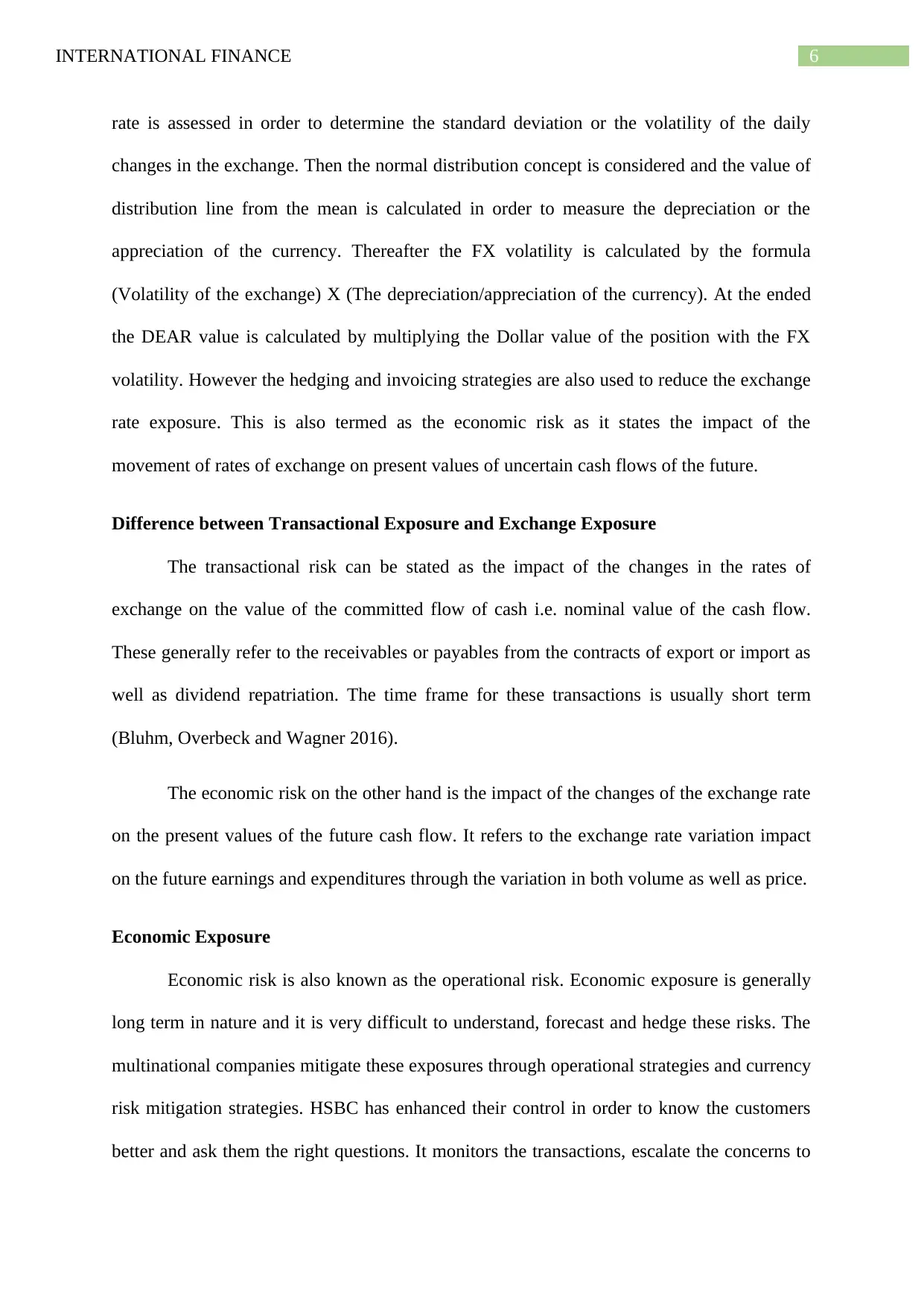
6INTERNATIONAL FINANCE
rate is assessed in order to determine the standard deviation or the volatility of the daily
changes in the exchange. Then the normal distribution concept is considered and the value of
distribution line from the mean is calculated in order to measure the depreciation or the
appreciation of the currency. Thereafter the FX volatility is calculated by the formula
(Volatility of the exchange) X (The depreciation/appreciation of the currency). At the ended
the DEAR value is calculated by multiplying the Dollar value of the position with the FX
volatility. However the hedging and invoicing strategies are also used to reduce the exchange
rate exposure. This is also termed as the economic risk as it states the impact of the
movement of rates of exchange on present values of uncertain cash flows of the future.
Difference between Transactional Exposure and Exchange Exposure
The transactional risk can be stated as the impact of the changes in the rates of
exchange on the value of the committed flow of cash i.e. nominal value of the cash flow.
These generally refer to the receivables or payables from the contracts of export or import as
well as dividend repatriation. The time frame for these transactions is usually short term
(Bluhm, Overbeck and Wagner 2016).
The economic risk on the other hand is the impact of the changes of the exchange rate
on the present values of the future cash flow. It refers to the exchange rate variation impact
on the future earnings and expenditures through the variation in both volume as well as price.
Economic Exposure
Economic risk is also known as the operational risk. Economic exposure is generally
long term in nature and it is very difficult to understand, forecast and hedge these risks. The
multinational companies mitigate these exposures through operational strategies and currency
risk mitigation strategies. HSBC has enhanced their control in order to know the customers
better and ask them the right questions. It monitors the transactions, escalate the concerns to
rate is assessed in order to determine the standard deviation or the volatility of the daily
changes in the exchange. Then the normal distribution concept is considered and the value of
distribution line from the mean is calculated in order to measure the depreciation or the
appreciation of the currency. Thereafter the FX volatility is calculated by the formula
(Volatility of the exchange) X (The depreciation/appreciation of the currency). At the ended
the DEAR value is calculated by multiplying the Dollar value of the position with the FX
volatility. However the hedging and invoicing strategies are also used to reduce the exchange
rate exposure. This is also termed as the economic risk as it states the impact of the
movement of rates of exchange on present values of uncertain cash flows of the future.
Difference between Transactional Exposure and Exchange Exposure
The transactional risk can be stated as the impact of the changes in the rates of
exchange on the value of the committed flow of cash i.e. nominal value of the cash flow.
These generally refer to the receivables or payables from the contracts of export or import as
well as dividend repatriation. The time frame for these transactions is usually short term
(Bluhm, Overbeck and Wagner 2016).
The economic risk on the other hand is the impact of the changes of the exchange rate
on the present values of the future cash flow. It refers to the exchange rate variation impact
on the future earnings and expenditures through the variation in both volume as well as price.
Economic Exposure
Economic risk is also known as the operational risk. Economic exposure is generally
long term in nature and it is very difficult to understand, forecast and hedge these risks. The
multinational companies mitigate these exposures through operational strategies and currency
risk mitigation strategies. HSBC has enhanced their control in order to know the customers
better and ask them the right questions. It monitors the transactions, escalate the concerns to
Paraphrase This Document
Need a fresh take? Get an instant paraphrase of this document with our AI Paraphraser
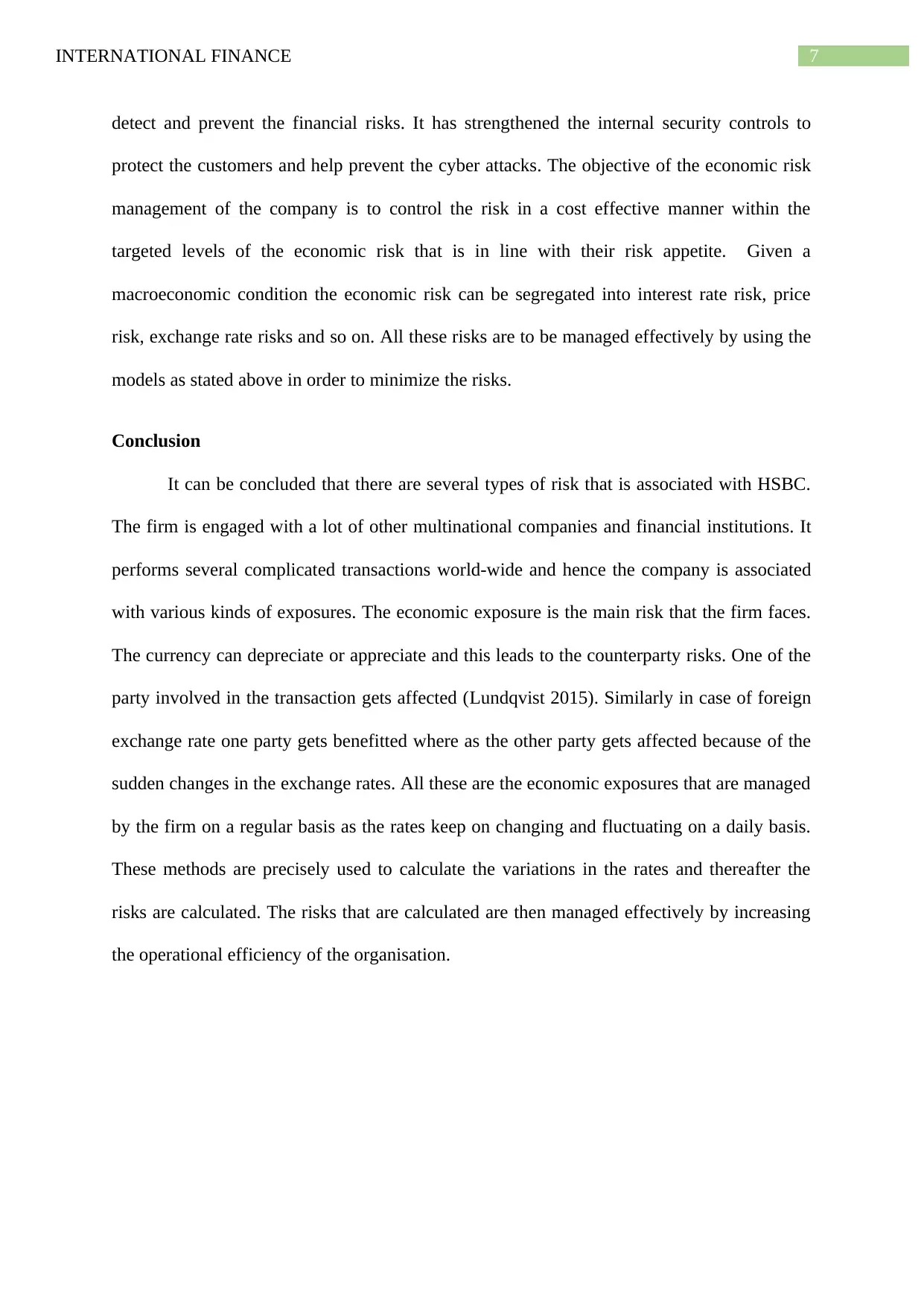
7INTERNATIONAL FINANCE
detect and prevent the financial risks. It has strengthened the internal security controls to
protect the customers and help prevent the cyber attacks. The objective of the economic risk
management of the company is to control the risk in a cost effective manner within the
targeted levels of the economic risk that is in line with their risk appetite. Given a
macroeconomic condition the economic risk can be segregated into interest rate risk, price
risk, exchange rate risks and so on. All these risks are to be managed effectively by using the
models as stated above in order to minimize the risks.
Conclusion
It can be concluded that there are several types of risk that is associated with HSBC.
The firm is engaged with a lot of other multinational companies and financial institutions. It
performs several complicated transactions world-wide and hence the company is associated
with various kinds of exposures. The economic exposure is the main risk that the firm faces.
The currency can depreciate or appreciate and this leads to the counterparty risks. One of the
party involved in the transaction gets affected (Lundqvist 2015). Similarly in case of foreign
exchange rate one party gets benefitted where as the other party gets affected because of the
sudden changes in the exchange rates. All these are the economic exposures that are managed
by the firm on a regular basis as the rates keep on changing and fluctuating on a daily basis.
These methods are precisely used to calculate the variations in the rates and thereafter the
risks are calculated. The risks that are calculated are then managed effectively by increasing
the operational efficiency of the organisation.
detect and prevent the financial risks. It has strengthened the internal security controls to
protect the customers and help prevent the cyber attacks. The objective of the economic risk
management of the company is to control the risk in a cost effective manner within the
targeted levels of the economic risk that is in line with their risk appetite. Given a
macroeconomic condition the economic risk can be segregated into interest rate risk, price
risk, exchange rate risks and so on. All these risks are to be managed effectively by using the
models as stated above in order to minimize the risks.
Conclusion
It can be concluded that there are several types of risk that is associated with HSBC.
The firm is engaged with a lot of other multinational companies and financial institutions. It
performs several complicated transactions world-wide and hence the company is associated
with various kinds of exposures. The economic exposure is the main risk that the firm faces.
The currency can depreciate or appreciate and this leads to the counterparty risks. One of the
party involved in the transaction gets affected (Lundqvist 2015). Similarly in case of foreign
exchange rate one party gets benefitted where as the other party gets affected because of the
sudden changes in the exchange rates. All these are the economic exposures that are managed
by the firm on a regular basis as the rates keep on changing and fluctuating on a daily basis.
These methods are precisely used to calculate the variations in the rates and thereafter the
risks are calculated. The risks that are calculated are then managed effectively by increasing
the operational efficiency of the organisation.
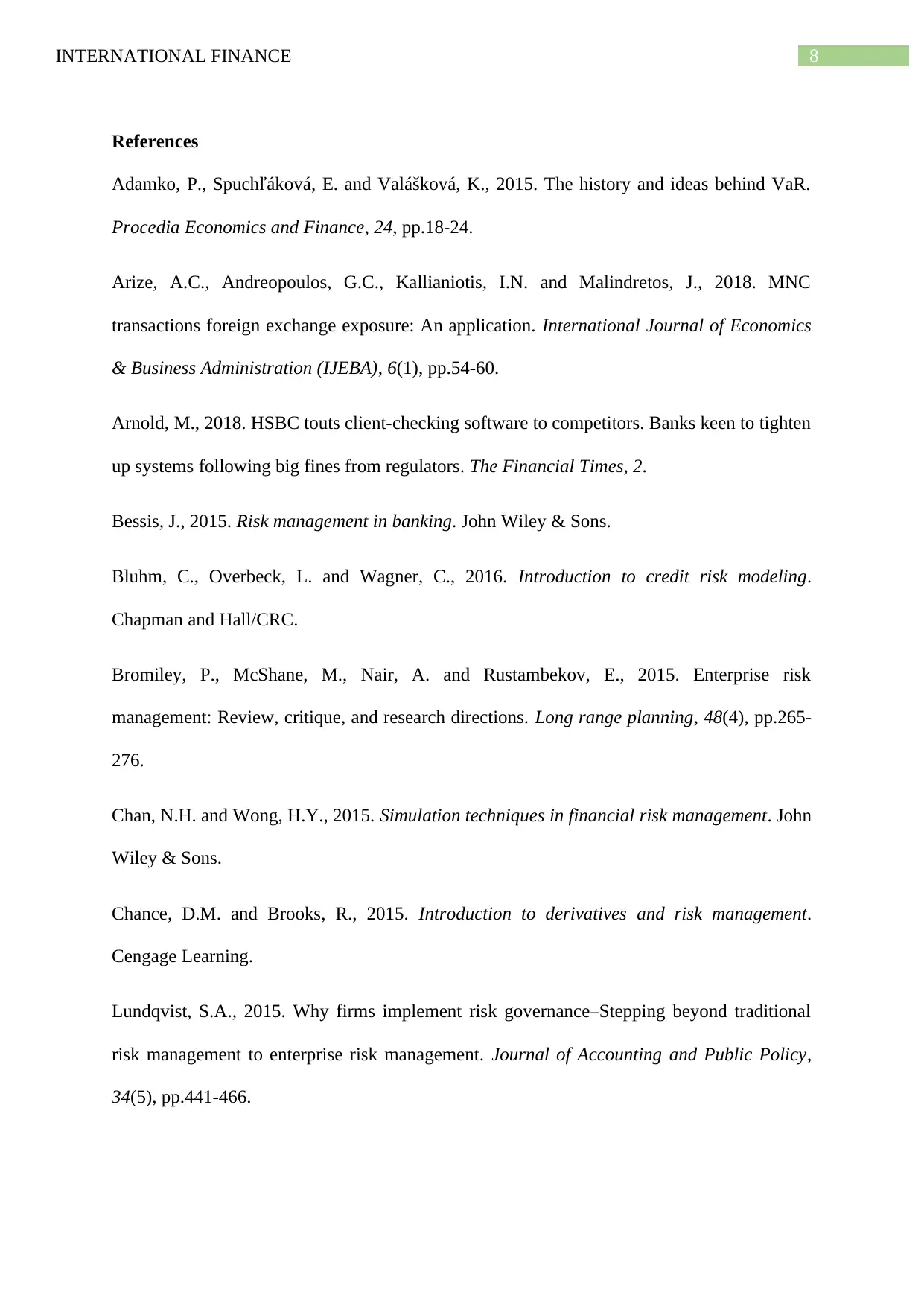
8INTERNATIONAL FINANCE
References
Adamko, P., Spuchľáková, E. and Valášková, K., 2015. The history and ideas behind VaR.
Procedia Economics and Finance, 24, pp.18-24.
Arize, A.C., Andreopoulos, G.C., Kallianiotis, I.N. and Malindretos, J., 2018. MNC
transactions foreign exchange exposure: An application. International Journal of Economics
& Business Administration (IJEBA), 6(1), pp.54-60.
Arnold, M., 2018. HSBC touts client-checking software to competitors. Banks keen to tighten
up systems following big fines from regulators. The Financial Times, 2.
Bessis, J., 2015. Risk management in banking. John Wiley & Sons.
Bluhm, C., Overbeck, L. and Wagner, C., 2016. Introduction to credit risk modeling.
Chapman and Hall/CRC.
Bromiley, P., McShane, M., Nair, A. and Rustambekov, E., 2015. Enterprise risk
management: Review, critique, and research directions. Long range planning, 48(4), pp.265-
276.
Chan, N.H. and Wong, H.Y., 2015. Simulation techniques in financial risk management. John
Wiley & Sons.
Chance, D.M. and Brooks, R., 2015. Introduction to derivatives and risk management.
Cengage Learning.
Lundqvist, S.A., 2015. Why firms implement risk governance–Stepping beyond traditional
risk management to enterprise risk management. Journal of Accounting and Public Policy,
34(5), pp.441-466.
References
Adamko, P., Spuchľáková, E. and Valášková, K., 2015. The history and ideas behind VaR.
Procedia Economics and Finance, 24, pp.18-24.
Arize, A.C., Andreopoulos, G.C., Kallianiotis, I.N. and Malindretos, J., 2018. MNC
transactions foreign exchange exposure: An application. International Journal of Economics
& Business Administration (IJEBA), 6(1), pp.54-60.
Arnold, M., 2018. HSBC touts client-checking software to competitors. Banks keen to tighten
up systems following big fines from regulators. The Financial Times, 2.
Bessis, J., 2015. Risk management in banking. John Wiley & Sons.
Bluhm, C., Overbeck, L. and Wagner, C., 2016. Introduction to credit risk modeling.
Chapman and Hall/CRC.
Bromiley, P., McShane, M., Nair, A. and Rustambekov, E., 2015. Enterprise risk
management: Review, critique, and research directions. Long range planning, 48(4), pp.265-
276.
Chan, N.H. and Wong, H.Y., 2015. Simulation techniques in financial risk management. John
Wiley & Sons.
Chance, D.M. and Brooks, R., 2015. Introduction to derivatives and risk management.
Cengage Learning.
Lundqvist, S.A., 2015. Why firms implement risk governance–Stepping beyond traditional
risk management to enterprise risk management. Journal of Accounting and Public Policy,
34(5), pp.441-466.
⊘ This is a preview!⊘
Do you want full access?
Subscribe today to unlock all pages.

Trusted by 1+ million students worldwide
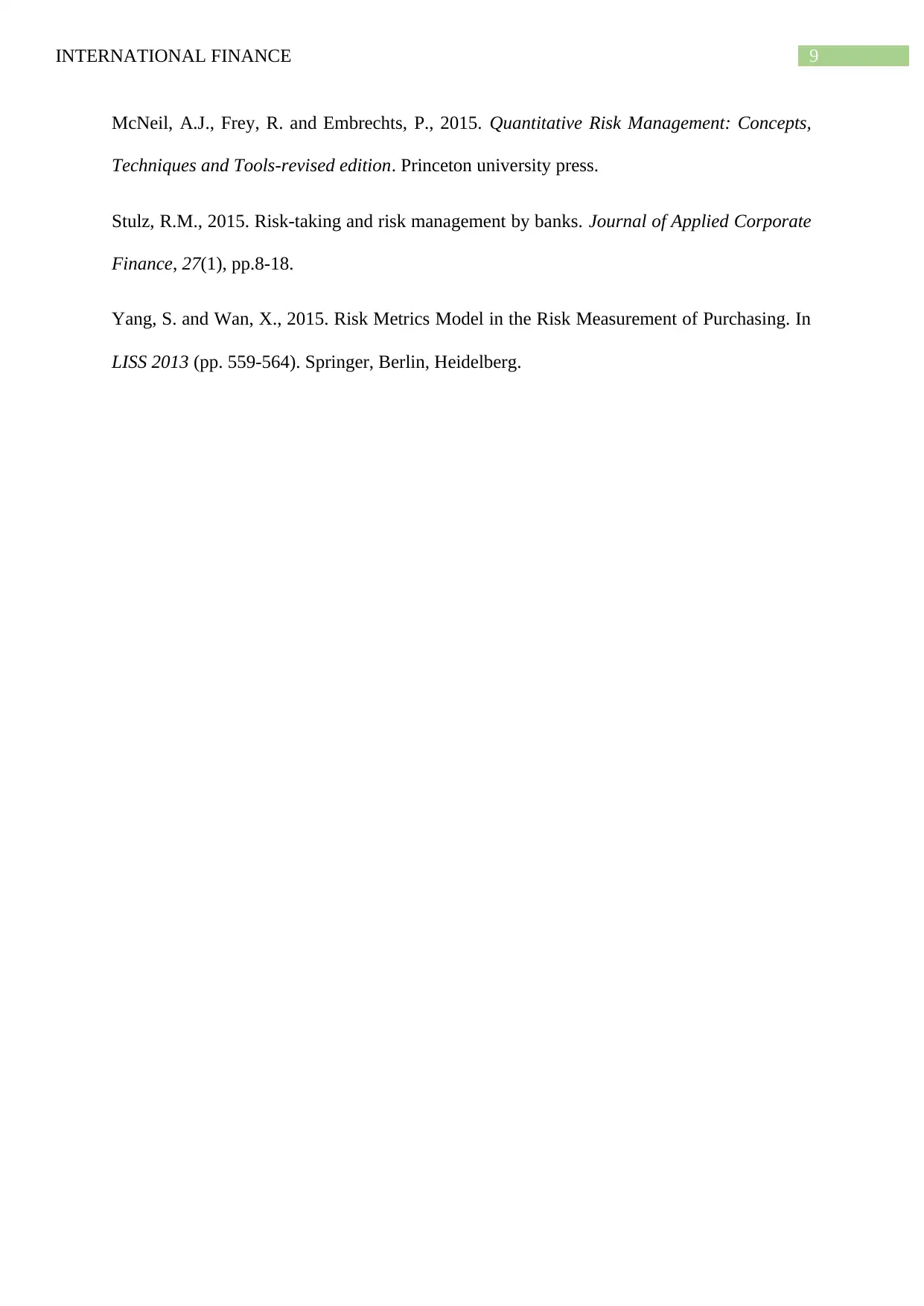
9INTERNATIONAL FINANCE
McNeil, A.J., Frey, R. and Embrechts, P., 2015. Quantitative Risk Management: Concepts,
Techniques and Tools-revised edition. Princeton university press.
Stulz, R.M., 2015. Risk‐taking and risk management by banks. Journal of Applied Corporate
Finance, 27(1), pp.8-18.
Yang, S. and Wan, X., 2015. Risk Metrics Model in the Risk Measurement of Purchasing. In
LISS 2013 (pp. 559-564). Springer, Berlin, Heidelberg.
McNeil, A.J., Frey, R. and Embrechts, P., 2015. Quantitative Risk Management: Concepts,
Techniques and Tools-revised edition. Princeton university press.
Stulz, R.M., 2015. Risk‐taking and risk management by banks. Journal of Applied Corporate
Finance, 27(1), pp.8-18.
Yang, S. and Wan, X., 2015. Risk Metrics Model in the Risk Measurement of Purchasing. In
LISS 2013 (pp. 559-564). Springer, Berlin, Heidelberg.
1 out of 10
Related Documents
Your All-in-One AI-Powered Toolkit for Academic Success.
+13062052269
info@desklib.com
Available 24*7 on WhatsApp / Email
![[object Object]](/_next/static/media/star-bottom.7253800d.svg)
Unlock your academic potential
Copyright © 2020–2025 A2Z Services. All Rights Reserved. Developed and managed by ZUCOL.





